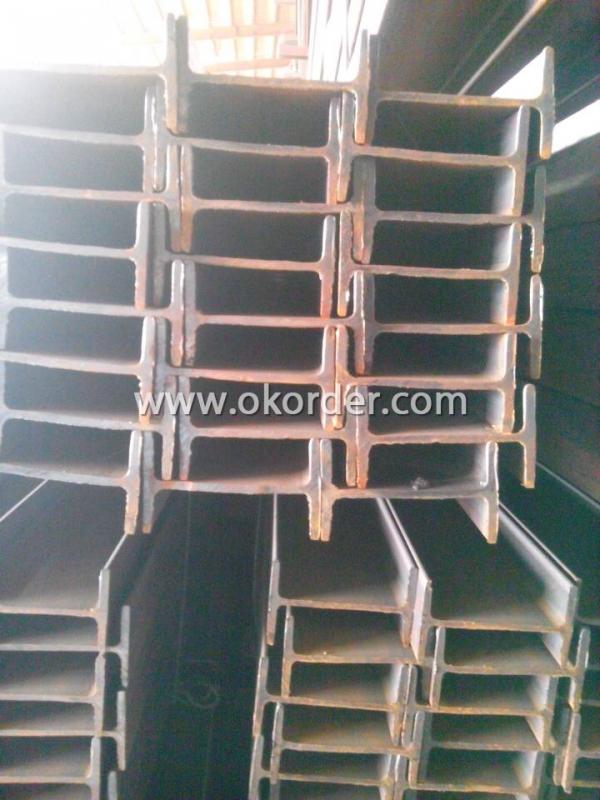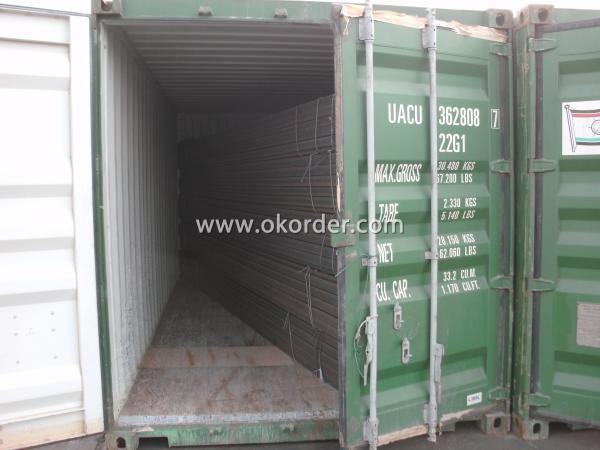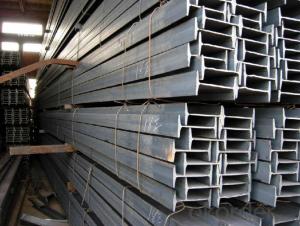High Quality Steel I Beam
- Loading Port:
- Tianjin Port, China
- Payment Terms:
- TT or LC
- Min Order Qty:
- 15MT m.t.
- Supply Capability:
- 10000MT m.t./month
OKorder Service Pledge
OKorder Financial Service
You Might Also Like
Specifications of High Quality Steel I Beam
Standard: EN10025, ASTM, GB Standard, DIN, JIS, etc.
Material of High Quality Steel I Beam:Q235, SS400, A36, S235JR, S275JR, etc
|
Alloy No. |
Grade |
C |
Mn |
S |
P |
Si |
|
Q235 |
B |
0.12%-0.20% |
0.3%-0.7% |
<=0.045% |
<=0.045% |
<=0.3% |
Sizes: 80MM-270MM
|
Section |
Standard Sectional Dimensions(mm) | ||||
|
|
h |
b |
s |
t |
Mass Kg/m |
|
IPE80 |
80 |
46 |
3.80 |
5.20 |
6.00 |
|
IPE100 |
100 |
55 |
4.10 |
5.70 |
8.10 |
|
IPE120 |
120 |
64 |
4.80 |
6.30 |
10.40 |
|
IPE140 |
140 |
73 |
4.70 |
6.90 |
12.90 |
|
IPE160 |
160 |
82 |
5.00 |
7.40 |
15.80 |
|
IPE180 |
180 |
91 |
5.30 |
8.00 |
18.80 |
|
IPE200 |
200 |
100 |
5.60 |
8.50 |
22.40 |
|
IPE220 |
220 |
110 |
5.90 |
9.20 |
26.20 |
|
IPE240 |
240 |
120 |
6.20 |
9.80 |
30.70 |
|
IPE270 |
270 |
135 |
6.60 |
10.20 |
36.10 |
|
IPEAA80 |
80 |
46 |
3.20 |
4.20 |
4.95 |
|
IPEAA100 |
100 |
55 |
3.60 |
4.50 |
6.72 |
|
IPEAA120 |
120 |
64 |
3.80 |
4.80 |
8.36 |
|
IPEAA140 |
140 |
73 |
3.80 |
5.20 |
10.05 |
|
IPEAA160 |
160 |
82 |
4.00 |
5.60 |
12.31 |
|
IPEAA180 |
180 |
91 |
4.30 |
6.50 |
15.40 |
|
IPEAA200 |
200 |
100 |
4.50 |
6.70 |
17.95 |
Length: 5.8M, 6M, 9M, 12M or as the requriements of the clients

Applications of High Quality Steel I Beam
According to the needs of different structures, steel I beams can compose to different force support component, and also can be the connections between components. They are widely used in various building structures and engineering structures such as roof beams, bridges, transmission towers, hoisting machinery and transport machinery, ships, industrial furnaces, reaction tower, container frame and warehouse etc.
Packaging & Delivery of High Quality Steel I Beam
1. Packing: it is nude packed in bundles by steel wire rod
2. Bundle weight: not more than 3.5MT for bulk vessel; less than 3 MT for container load

3. Marks:
Color marking: There will be color marking on both end of the bundle for the cargo delivered by bulk vessel. That makes it easily to distinguish at the destination port.
Tag mark: there will be tag mark tied up on the bundles. The information usually including supplier logo and name, product name, made in China, shipping marks and other information request by the customer.
If loading by container the marking is not needed, but we will prepare it as customer request.
4. Transportation: the goods are delivered by truck from mill to loading port, the maximum quantity can be loaded is around 40MTs by each truck. If the order quantity cannot reach the full truck loaded, the transportation cost per ton will be little higher than full load.

5. Delivered by container or bulk vessel

6. Delivery time: All the structural steel I beams will be at the port of the shipment within 45 days after receiving the L/C at sight ot the advance pyment.
7. Payment: L/C at sight; 30% advance payment before production, 70% before shipment by T/T, etc.
Production flow of High Quality Steel I Beam
Material prepare (billet) —heat up—rough rolling—precision rolling—cooling—packing—storage and transportation

- Q:What is the moment of inertia and the moment of resistance of section No. 16 for I-beam?
- Basic differenceI-beam is mainly divided into ordinary I-beam, light I-beam and H steel three.Ordinary I-beam, light I-beam flange is variable cross-section, depending on the thickness of the web, the external thin; H steel: HW, HM, HN, HEA, HEB, HEM and so on, the flange of I-beam is a uniform sectionOrdinary I-beam, lightweight I-beam has formed the national standard, the common 10# I-beam is equivalent to the Internet I100 (such as 10# also channel equivalent channel (U100) for the implementation of the standards of different countries, which have subtle differences in their specifications)H type I-beam is also called wide flange I-beam, HW, HM, HN originated from European standards, HEB is the German standard of I-beam, of which HW, HN I-beam has been widely used in our country and production. HEA HEB HEM will be seen on many German designs and is hard to buy on the domestic market. In the domestic steel structure engineering, if the quantity is few, then may use the specification steel plate to carry on the welding splicing. In the case of large quantities, it is usually considered to use mechanical properties comparable to those of HW and HN steel.
- Q:How do steel I-beams handle vibrations?
- Steel I-beams are highly effective in handling vibrations due to their inherent structural properties. The shape of an I-beam, with its flanges and web, provides a high degree of stiffness and rigidity. This enables the beam to effectively distribute loads and resist bending, twisting, and deformations caused by vibrations. The web of the I-beam acts as a vertical support, while the flanges act as horizontal beams that resist bending and provide additional strength. This design allows the I-beam to efficiently transfer loads and vibrations through its entire length, minimizing the risk of structural failure or damage. Moreover, steel itself is known for its high strength and durability, which helps in absorbing and dissipating vibrations. Steel is less prone to resonance, meaning it does not easily vibrate at its natural frequency. This characteristic prevents amplification of vibrations and reduces the risk of fatigue failure. In addition, the weight and mass of steel I-beams contribute to their ability to handle vibrations. The substantial weight of the beams helps dampen and absorb vibrations, preventing them from propagating throughout the structure. This makes steel I-beams particularly well-suited for applications where vibrations are a concern, such as in bridges, high-rise buildings, and industrial structures. Overall, steel I-beams are designed and engineered to effectively handle vibrations. Their shape, material properties, and weight make them a reliable choice for structural applications where vibration control and stability are crucial.
- Q:What is the typical lifespan of steel I-beams?
- Several factors, including the quality of the steel used, the installation environment, and the level of maintenance, can affect the typical lifespan of steel I-beams. However, steel I-beams are generally designed to have a very long lifespan. Under normal conditions, they can last for several decades or longer without any significant deterioration or structural issues. By properly caring for and maintaining them, through regular inspections and necessary repairs, steel I-beams can remain structurally sound and functional for an extended period. It's important to consider factors like exposure to corrosive environments or excessive loads, as these can potentially shorten the lifespan of steel I-beams. Furthermore, advancements in steel manufacturing and coating technologies have enhanced their durability and longevity, making them even more reliable and long-lasting.
- Q:What are the different types of steel I-beams?
- There are several different types of steel I-beams, each designed to meet specific structural needs and requirements. Some of the most common types include: 1. W-Beam: This is the most commonly used type of I-beam and features a wide flange section that resembles the letter "W". It provides excellent support and load-bearing capabilities, making it suitable for a wide range of applications. 2. S-Beam: Also known as American Standard Beams, S-beams have a narrower flange section that resembles the letter "S". They are commonly used in residential construction and light to medium-duty applications. 3. HP-Beam: HP-beams, also known as H-piles, feature a wider flange section and are primarily used for deep foundation applications, such as supporting large structures or bridges. They provide excellent load-bearing capacity and resistance to lateral forces. 4. M-Beam: M-beams, or miscellaneous beams, are typically used for smaller-scale applications or where specific load requirements need to be met. They come in various sizes and are commonly used in the construction industry for framing, support structures, and other similar applications. 5. L-Beam: L-beams, or angle beams, have two legs that form an L-shape. They are primarily used for structural purposes, such as providing support for columns, beams, or as braces in construction projects. 6. C-Beam: C-beams, or channel beams, have a C-shaped cross-section and are commonly used for structural purposes, such as framing, support, or as tracks for sliding doors or windows. These are just a few examples of the different types of steel I-beams available. It is essential to choose the right type based on the specific requirements of the project, including load-bearing capacity, span, and structural needs. Consulting with a structural engineer or steel supplier can help determine the most suitable type of I-beam for a particular application.
- Q:What are the different types of load tests conducted on Steel I-Beams?
- There are several types of load tests conducted on Steel I-Beams, including ultimate strength tests, yield strength tests, and fatigue tests. Ultimate strength tests determine the maximum load a beam can withstand before failure, while yield strength tests measure the load at which the beam begins to deform permanently. Fatigue tests subject the beam to repeated loading and unloading cycles to assess its resistance to fatigue failure over time.
- Q:Are steel I-beams suitable for supporting rooftop gardens with water features?
- Yes, steel I-beams are suitable for supporting rooftop gardens with water features. Steel I-beams are known for their strength and load-bearing capacity, making them an excellent choice for supporting the weight of rooftop gardens and water features. Additionally, steel is durable, resistant to corrosion, and can withstand various weather conditions, making it a reliable option for long-term support.
- Q:What are the standard sizes of steel I-beams?
- Different organizations and industry standards dictate the standard sizes of steel I-beams, resulting in variations. Nonetheless, there are commonly used sizes prevalent in construction and structural engineering. The American Institute of Steel Construction (AISC) in the United States offers a comprehensive list of standard sizes for steel I-beams. These sizes encompass a range from S3x5.7 to S24x121, incorporating different dimensions such as depth, flange width, and weight per foot. Similarly, the European I-beam (IPE) sizes, recognized worldwide, adhere to another standard. IPE sizes span from IPE80 to IPE750, featuring diverse measurements for depth, flange width, and weight per meter. Apart from these American and European standards, individual countries might establish their own standard sizes for steel I-beams. It is crucial to consult relevant national or international standards when selecting the appropriate size for a specific application. It is worth noting that the sizes mentioned are merely a few examples of standard sizes, and availability may vary based on the manufacturer and location. It is always advisable to seek advice from an engineer or professional in the field to determine the most suitable size for a particular project or design requirement.
- Q:What are the common methods of connecting steel I-beams to other structural elements?
- There are multiple ways to connect steel I-beams to other structural elements. Welding, bolting, and using connection plates or cleats are some common methods employed. Welding is a favored technique for joining steel I-beams with other elements. It involves melting the edges of the steel members and fusing them to form a robust joint. Welding offers exceptional strength and rigidity and is frequently utilized for permanent connections. Another prevalent method is bolting, which involves using bolts, nuts, and washers to secure the beams to other elements. Bolting allows for easy reversibility, enabling disassembly if necessary. It is commonly applied in temporary structures or situations where future modifications may be required. Connection plates or cleats are frequently utilized to connect steel I-beams with other structural elements. These plates, typically made of steel, are attached to the flanges or webs of the beams using welding or bolting. Connection plates provide a larger surface area for load distribution and ensure a secure connection. Additionally, specialized connectors are available for specific applications. Moment connections transfer bending forces between beams, while shear connectors transfer shear forces. These types of connections often necessitate more intricate designs and are typically found in larger and more demanding structures. The choice of connection method depends on various factors, including structural requirements, loads, and design considerations. Professional engineers and designers carefully analyze these factors to determine the most suitable method for connecting steel I-beams to other structural elements.
- Q:How do steel I-beams perform in high-wind bridge applications?
- Steel I-beams perform well in high-wind bridge applications due to their inherent strength and structural properties. These beams are designed to withstand lateral forces, including wind loads, which makes them an ideal choice for bridges located in areas prone to high winds. The I-beam's shape, with a flange on either side of a central web, provides excellent resistance to bending and torsion. This design allows the beam to distribute the wind load evenly across its length, reducing the chances of structural failure. Additionally, steel I-beams have a high strength-to-weight ratio, meaning they can support heavy loads while remaining relatively lightweight. This characteristic is crucial in high-wind bridge applications as it allows for efficient and cost-effective construction. Furthermore, steel is a durable material that can withstand weathering and corrosion, ensuring the long-term integrity of the bridge. This is particularly important in high-wind environments where exposure to harsh elements is common. To enhance the performance of steel I-beams in high-wind applications, engineering techniques such as aerodynamic profiling and wind tunnel testing are often employed. These measures help to optimize the beam's design and ensure its stability under extreme wind conditions. In conclusion, steel I-beams are highly suitable for high-wind bridge applications due to their strength, resistance to bending and torsion, high strength-to-weight ratio, and durability. When properly designed and implemented, they provide a reliable and safe solution for bridges in areas prone to strong winds.
- Q:The steel structure of the web and flange how to distinguish?
- This is for I-beam H section steel. The two plate is parallel to the flange, the middle one is web.
1. Manufacturer Overview |
|
|---|---|
| Location | Qinhuangdao, China |
| Year Established | 2000 |
| Annual Output Value | Above US$ 300 Million |
| Main Markets | Mid East; Africa; Southeast Asia; Brazil |
| Company Certifications | ISO 9001:2008; |
2. Manufacturer Certificates |
|
|---|---|
| a) Certification Name | |
| Range | |
| Reference | |
| Validity Period | |
3. Manufacturer Capability |
|
|---|---|
| a)Trade Capacity | |
| Nearest Port | Tianjin; |
| Export Percentage | 70% - 80% |
| No.of Employees in Trade Department | 21-50 People |
| Language Spoken: | English; Chinese; |
| b)Factory Information | |
| Factory Size: | Above 400,000 square meters |
| No. of Production Lines | 2 |
| Contract Manufacturing | OEM Service Offered; |
| Product Price Range | Average |
Send your message to us
High Quality Steel I Beam
- Loading Port:
- Tianjin Port, China
- Payment Terms:
- TT or LC
- Min Order Qty:
- 15MT m.t.
- Supply Capability:
- 10000MT m.t./month
OKorder Service Pledge
OKorder Financial Service
Similar products
New products
Hot products
Hot Searches
Related keywords




























